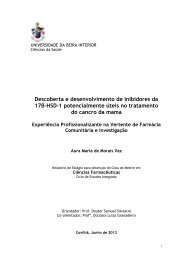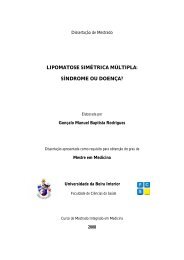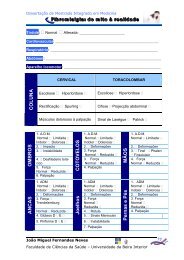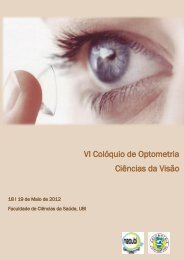prótese total do joelho – a história da arte: revisão bibliográfica
prótese total do joelho – a história da arte: revisão bibliográfica
prótese total do joelho – a história da arte: revisão bibliográfica
You also want an ePaper? Increase the reach of your titles
YUMPU automatically turns print PDFs into web optimized ePapers that Google loves.
A Prótese Total <strong>do</strong> Joelho: A História <strong>da</strong> Arte <strong>–</strong> Revisão Bibliográfica<br />
1.2.5 - Ligamentos Intra-Articulares<br />
Os ligamentos cruza<strong>do</strong>s unem o fémur e a tíbia, cruzan<strong>do</strong> dentro<br />
<strong>da</strong>cápsula articular <strong>da</strong> articulação, mas fora <strong>da</strong> cavi<strong>da</strong>de articular sinovial. Os<br />
ligamentos cruza<strong>do</strong>s estão localiza<strong>do</strong>s no centro <strong>da</strong> articulação e cruzam um<br />
com o outro, obliquamente, como na letra X, fornecen<strong>do</strong> estabili<strong>da</strong>de para a<br />
articulação <strong>do</strong> <strong>joelho</strong>.<br />
O ligamento cruza<strong>do</strong> anterior (LCA) tem origem na área intercondiliana<br />
anterior <strong>da</strong> tíbia, imediatamente atrás <strong>da</strong> fixação <strong>do</strong> menisco medial: ele<br />
estende-se para cima, para trás e lateralmente para se fixar à p<strong>arte</strong> posterior<br />
<strong>do</strong> la<strong>do</strong> medial <strong>do</strong>côndilo lateral <strong>do</strong> fémur. O LCA possui um suprimento<br />
sanguíneo relativamente escasso. É afrouxo quan<strong>do</strong> o <strong>joelho</strong> é flecti<strong>do</strong> e tenso<br />
quan<strong>do</strong> está completamente destendi<strong>do</strong>, impedin<strong>do</strong> o deslocamento posterior<br />
<strong>do</strong> fémur sobre a tíbia e a hiper-extensão <strong>da</strong> articulação <strong>da</strong> <strong>joelho</strong>. Quan<strong>do</strong> a<br />
articulação é flecti<strong>da</strong>, forman<strong>do</strong> um ângulo recto, a tíbia não pode ser<br />
traciona<strong>da</strong> anteriormente porque é conti<strong>da</strong> pelo ligamento cruza<strong>do</strong> anterior<br />
(LCA).<br />
O ligamento cruza<strong>do</strong> posterior (LCP) é o mais forte <strong>do</strong>s <strong>do</strong>is ligamentos<br />
cruza<strong>do</strong>s, ten<strong>do</strong> origem na área intercondiliana posterior <strong>da</strong> tíbia. O LCP passa<br />
acima e à frente <strong>do</strong> la<strong>do</strong> medial <strong>do</strong> ligamento cruza<strong>do</strong> anterior, para se fixar na<br />
p<strong>arte</strong> anterior <strong>da</strong> face lateral <strong>do</strong> côndilo medial <strong>do</strong> fémur. O ligamento cruza<strong>do</strong><br />
posterior é estira<strong>do</strong> durante a flexão <strong>da</strong> articulação <strong>do</strong> <strong>joelho</strong>, impedin<strong>do</strong> o<br />
deslocamento anterior <strong>do</strong> fémur sobre a tíbia ou o deslocamento posterior <strong>da</strong><br />
tíbia sob o fémur. Também aju<strong>da</strong> a impedir a hiper-extensão <strong>da</strong> articulação <strong>do</strong><br />
Pedro Miguel Gonçalves Oliveira e Silva<br />
19








